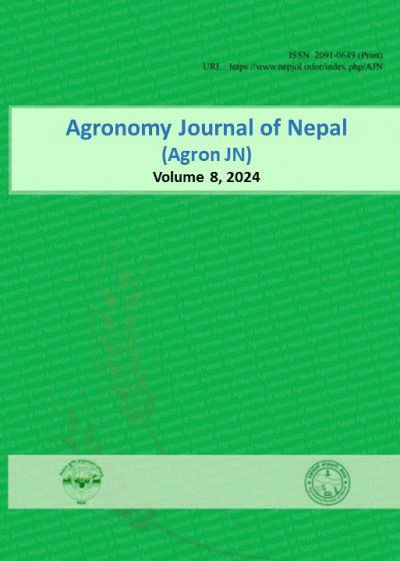Effect of Crop Establishment Method, Residue and Nutrient Management on Productivity of Rice-Wheat Cropping System at Rupandehi, Bhairahawa, Nepal
DOI:
https://doi.org/10.3126/ajn.v8i1.70757Keywords:
Surface seeding, system yields, Un-puddled transplanting, Zero tillageAbstract
The puddling operation and multiple tillage operations done in traditional rice-wheat system have negative impact on soil resulting into low productivity of rice - wheat system. A field experiment was conducted to find the alternate practices for enhancing the productivity of rice-wheat system at National Wheat Research Program, Bhairahawa during 2018/19. Three crop establishment methods: surface seeded wheat (SSW) followed by (fb) unpuddled transplanted rice (U-TPR), zero tilled wheat (ZTW) fb zero tilled direct seeded rice (ZT-DSR) and conventionally tilled wheat (CTW) fb puddled transplanted rice (PTR) were tested in two levels of residue management: residue removed (R0) and residue retention (R50). Three levels of nutrient management: recommended dose of NPK (F100), 25% higher dose of NPK (F125) and farmer’s practice (FP) were assigned in wheat. Strip-split plot design with 3 replications was used in wheat while strip-plot design with 9 replications was used in rice. Crop establishment methods (CSM) were assigned in vertical strips; residue management in horizontal blocks and nutrient management were assigned in subplots. The number of tillers at maximum tillering stage, maximum leaf area index, effective tiller per square meter and number of grains per spike of wheat were significantly affected by CSM, where ZTW had shown better results (413.7 tillers, 2.12 LAI, 224.1 effective tiller per square meter and 34.27 grains per spike) than SSW and CTW but the CSM had no significant effect on grain yield of both rice and wheat crop. R0 had produced significantly higher straw yield than R50 of both rice and wheat, whereas, R50 had produced significantly higher harvest index than R0 in rice. The application of 25% more nutrients than the recommended dose resulted in the significantly better growth, yield attributes, and yield of wheat. The ZTW fb ZT-DSR had produced significantly higher system yield than SSW fb U-TPR where, CTW fb PTR was statistically at par with both systems. The recommended dose of nutrients (F100) and 25% higher than F100 (F125) had produced significantly higher system yield than farmer’s practice (FP) dose. Research results revealed that ZTW fb ZT-DSR system can be suggested instead of traditional CTW fb PTR system without significant yield differences.
Downloads
Downloads
Published
How to Cite
Issue
Section
License
Copyright (c) 2024 Agronomy Society of Nepal (ASoN)

This work is licensed under a Creative Commons Attribution-NonCommercial 4.0 International License.
ASON permits for free use, distribution and reproduction in any medium if the original work is properly cited and not used for commercial purposes.




